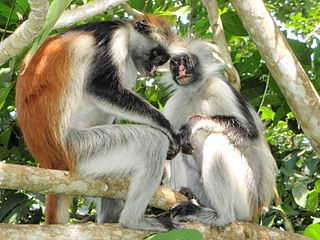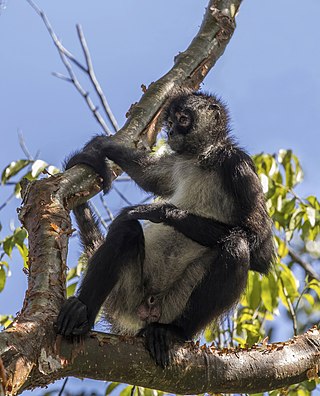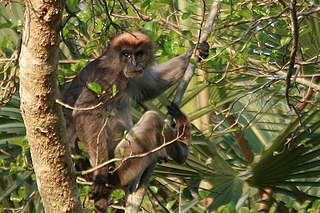Biology
Ursine colobus are diurnal and highly arboreal, coming down from trees only occasionally when feeding. Their social behavior is like that of many polygynous monkeys, with each group consisting of related females their juvenile offspring and a territorial male. The males are highly territorial and disperse upon reaching sexual maturity. [3]
Ursine colobus use a roaring call to advertise territory and location, this roar is a low "rur, rur, rur" noise. They also have alarm calls that alert group members when predators have been seen which are a "snorting" sound, made by all members of the group except infants. [3]
Ursine colobus are mainly vegetarian and have a diet which is made up of new leaves and seeds, with the occasional addition of fruits, insects, and termite clay. [3]

Black-and-white colobuses are Old World monkeys of the genus Colobus, native to Africa. They are closely related to the red colobus monkeys of genus Piliocolobus. There are five species of this monkey, and at least eight subspecies. They are generally found in high-density forests where they forage on leaves, flowers and fruit. Social groups of colobus are diverse, varying from group to group. Resident-egalitarian and allomothering relationships have been observed among the female population. Complex behaviours have also been observed in this species, including greeting rituals and varying group sleeping patterns. Colobi play a significant role in seed dispersal.

The Diana monkey is an Old World monkey found in the high canopy forests in Sierra Leone, Liberia, and western Côte d’Ivoire. Named for its white brow which is said to resemble the bow of the Roman goddess Diana, this black-grey guenon has a white throat, crescent-shaped browband, ruff and beard.

The Zanzibar red colobus is a species of red colobus monkey endemic to Unguja, the main island of the Zanzibar Archipelago, off the coast of Tanzania. It is also known as Kirk's red colobus after Sir John Kirk, the British Resident of Zanzibar who first brought it to the attention of zoological science. It is now classified as an endangered species and in the mid-1990s was adopted as the flagship species for conservation in Zanzibar. The population is still decreasing, and conservationists are attempting to work with the local government to devise a proper, effective strategy to protect the population and habitat. Challenges include the species' habitat, which is limited to the archipelago. The species has been reclassified three times; it was previously in the genus Colobus, then in the genus Procolobus, and later in the genus Piliocolobus.

The king colobus, also known as the western black-and-white colobus, is a species of Old World monkey, found in lowland and mountain rainforests in a region stretching from Senegal, through Guinea-Bissau, Guinea, Sierra Leone and Liberia to the Ivory Coast. One of five members of the genus Colobus, the black-and-white colobuses, the king colobus is the westernmost species of the group on the continent of Africa. It eats mainly leaves, but also fruits and flowers. Though it is arboreal, it eats primarily on the ground. It lives in small groups consisting of 3 to 4 females and 1 to 3 males, plus their young. These groups maintain distance from one another through territorial calling.

The mantled guereza, also known simply as the guereza, the eastern black-and-white colobus, or the Abyssinian black-and-white colobus, is a black-and-white colobus, a type of Old World monkey. It is native to much of west central and east Africa, including Cameroon, Equatorial Guinea, Nigeria, Ethiopia, Kenya, Tanzania, Uganda and Chad. The species consists of several subspecies that differ in appearance. It has a distinctive appearance, which is alluded to in its name; the long white fringes of hair that run along each side of its black trunk are known as a mantle. Its face is framed with white hair and it has a large white tail tuft.

Red colobuses are Old World monkeys of the genus Piliocolobus. It was formerly considered a subgenus within the genus Procolobus, which is now restricted to the olive colobus. They are closely related to the black-and-white colobus monkeys, and some species are often found in groups with the blue monkey. The western red colobus is frequently hunted by the common chimpanzee.

Geoffroy's spider monkey, also known as the black-handed spider monkey or the Central American spider monkey, is a species of spider monkey, a type of New World monkey, from Central America, parts of Mexico and possibly a small portion of Colombia. There are at least five subspecies. Some primatologists classify the black-headed spider monkey, found in Panama, Colombia, and Ecuador as the same species as Geoffroy's spider monkey.

Miss Waldron's red colobus is a species of the red colobus native to West Africa. It had previously been described as a subspecies of the western red colobus, P. badius. It has not been officially sighted since 1978 and was considered extinct in 2000. However, new evidence suggests that a very small number of these monkeys may be living in the southeast corner of Côte d'Ivoire. The IUCN Red List notes Miss Waldron's red colobus as critically endangered.

The Angola colobus, Angolan black-and-white colobus, or Angolan colobus is a primate species of Old World monkey belonging to the genus Colobus.

The black colobus, or satanic black colobus, is a species of Old World monkey belonging to the genus Colobus. The species is found in a small area of western central Africa. Black colobuses are large, completely covered with black fur, and like all other Colobus monkeys, do not have a thumb. The species has faced large declines in population due to habitat destruction and hunting by humans, and was consequently listed as Vulnerable on the IUCN Red List in 1994.

The crested mona monkey, also known as the crowned guenon, crowned monkey, golden-bellied guenon, or golden-bellied monkey,, is a species of African primate in the family Cercopithecidae found in west central Africa.

The Tana River red colobus, also called the eastern red colobus, is a highly endangered species of primate in the family Cercopithecidae. It is endemic to a narrow zone of gallery forest near the Tana River in southeastern Kenya.

The olive colobus monkey, also known as the green colobus or Van Beneden's colobus, is a species of primate in the family Cercopithecidae. Its English name refers to its dull olive upperparts. It is the smallest example of all colobine monkeys and is rarely observed in its natural habitat because of its cryptic coloration and secretive nature. It is found in the rain forests of West Africa, ranging from southern Sierra Leone to Nigeria. The IUCN Red List classifies the olive colobus as vulnerable, with the cause of its decline attributed to habitat loss and hunting. Though much of the land within the range of the olive colobus has been affected by human activities, it retains its ability to thrive in small degraded forest fragments.

The Bini free-tailed bat is a species of bat in the family Molossidae found in West and Central Africa. Its natural habitat is subtropical or tropical moist lowland forests.

The Ugandan red colobus or ashy red colobus is an endangered species of red colobus monkey, recognised as a distinct species since 2001. There is disagreement however over taxonomy with many considering the Ugandan red colobus to be a subspecies. The Ugandan red colobus is an Old World monkey which is found in five different locations across Uganda and Tanzania.

The Osman Hill's mangabey, also known as the rusty-mantled mangabey, is a subspecies of the grey-cheeked mangabey, a crested mangabey in the family Cercopithecidae, with a restricted distribution in West Africa.

The Niger Delta red colobus is a critically endangered species of colobus monkey endemic to the western part of the Niger Delta. It is threatened by hunting and habitat loss.

Bouvier's red colobus is a species of colobus monkey rediscovered in the Republic of the Congo in 2015, after four decades without a confirmed sighting.

Foa's red colobus or the Central African red colobus, is a species of red colobus monkey found in the Democratic Republic of the Congo.




















